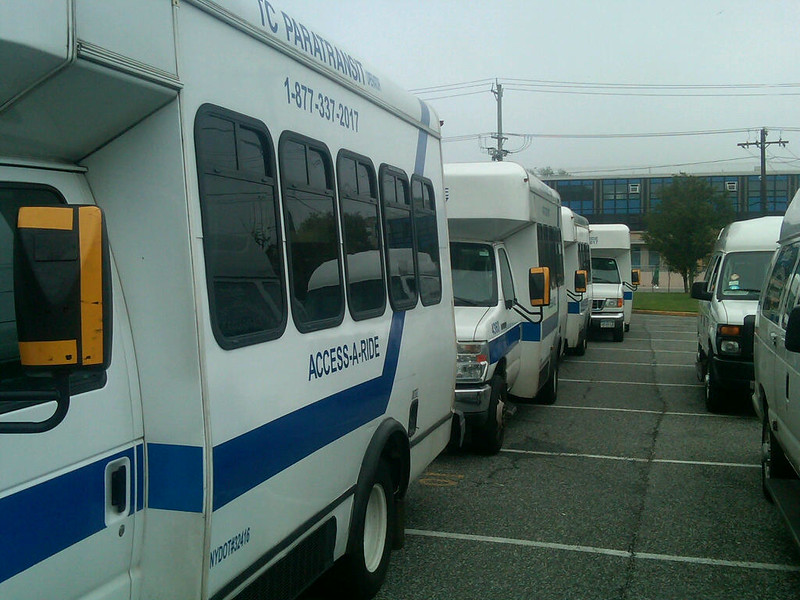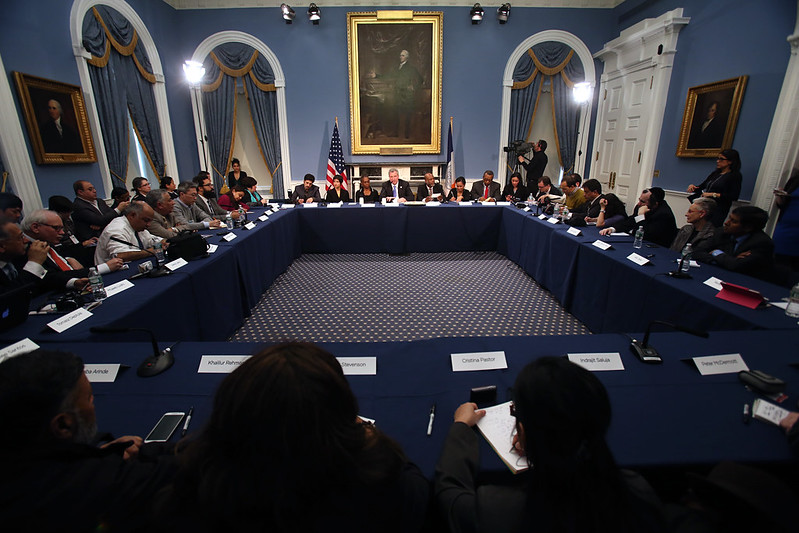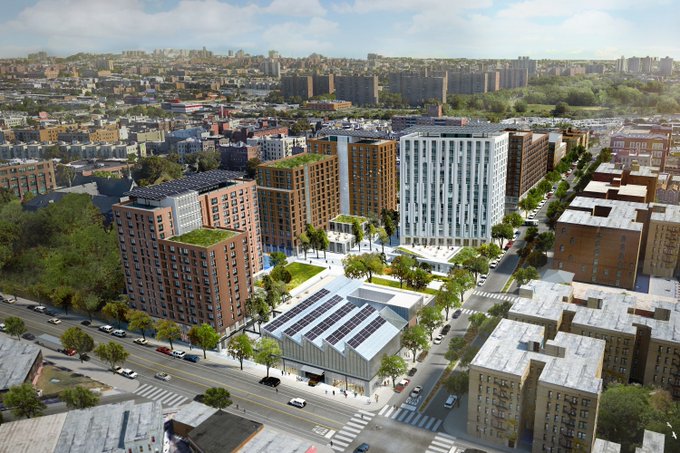It’s Time to Bring MTA’s Paratransit Into the 21st Century

(photo: MTA)
There is a reason why Access-A-Ride is better known as “Stress-A-Ride” for the approximately 170,000 New Yorkers who depend on it.
The bill for Access-A-Ride will hit $616 million this year and the MTA is seeking additional funding from the City of New York. It’s mind-boggling to think this service can cost the cash-strapped agency so much for such low-quality service. That’s why before anyone kicks in additional funding, the MTA must fundamentally transform the way it runs its paratransit program and bring it into the 21st century.
New York City Transit (NYCT), which is part of the MTA, administers paratransit service, which provides 24/7 shared-ride, door-to-door transportation through the five boroughs and in parts of Westchester and Long Island. The scale and scope of this service is unmatched by any other transit system in the nation. However, disability advocates and budget watchdog groups alike have observed for years that the MTA’s byzantine approach to paratransit services leads to inefficiencies and a lack of transparency and accountability, culminating in the highest cost-per-trip ($68.71) in the country. The second most expensive (Chicago) is half the MTA’s at $38. Why?
Fundamentally, the way the MTA contracts its paratransit services is both cumbersome and inefficient. Right now, the MTA provides Access-A-Ride through a constellation of for-profit and not-for-profit contractors, including 13 Dedicated Carriers, which use specially-equipped buses and cars owned by NYCT, and two Broker Car Service Providers, which provide transportation services to ambulatory passengers through a network of subcontracted livery and black car service providers.
And there are separate contracts that govern Access-A-Ride’s eligibility determination unit, the command center which receives trip requests and designs schedules and routes, and the carriers that complete those trips. Is your head spinning yet?
In addition, more than half of Access-A-Ride trips are “ambulatory” for people who are able to walk to, enter, and exit vehicles without assistance. Vehicles with special equipment are not necessary for these trips. Putting people in taxis or other for-hire vehicles is cheaper. A single trip under the e-hail program costs the authority $35.91. The same Access-A-Ride trip costs the MTA $68.71.
So how could we turn things around for Access-A-Ride?
Instead of over a dozen contractors and vendors to provide paratransit services, the MTA should unify the entire system with a single, full-service technology platform to handle all relationships with vehicle providers. The MTA could streamline management of Access-A-Ride and ambulatory services, encourage more competitive bidding, and lower administrative costs.
In the last five years, reports by experts at the Citizens Budget Commission, NYU Rudin Transportation Center, and Comptroller Scott Stringer’s office all point to the burdensome administrative and coordination layers that are the direct result of multiple types of contracts and vendors at every step of the service: verification, booking, dispatching, routing, vehicle operations, customer service, etc.
While they’re at it, the MTA should require that this platform enable on-demand rides in real-time so that people are no longer forced to call to reserve a trip one to two days in advance and wait to be given an unpredictable and often inaccurate pickup time.
We should have a system to match paratransit customers to right-sized vehicles from a variety of modes; increase efficient sharing and routing of vehicles; and create more transparency and accountability for quality-of-service and customer complaints. The technology for this solution is well-established and the MTA should begin the work immediately to transition to such a system.
In the meantime, it should build on the success of the e-hail program – the MTA’s one innovation in this space in recent memory – instead of curtailing it. The pilot provided the city’s paratransit customers with rides in yellow or green taxis through an e-hail app, Curb or Arro, but was only made available to 1,200 users, less than 1% of the service’s customers. The MTA is now looking to severely limit the one bright spot in its paratransit program by capping rides and having customers pay more. It should instead improve the program.
Most of the rides currently booked through the e-hail pilot are single-passenger rides, but where appropriate we should use ride-matching technology to have more multi-passenger ambulatory trips as a way to lower cost-per-trip.
The MTA recently held a conference inviting technology companies to share ideas for slashing time and cost of modernizing the antiquated signal system in the subway. Mark Dowd, the new Chief Innovation Officer at the MTA, declared, “We are looking for cutting-edge technologies, technologies that may have not been designed for this purpose, but can be applied to this purpose.” The MTA needs to apply this type of thinking to transform the costly and antiquated paratransit program. Now.
***
City Council Member Justin Brannan represents parts of Brooklyn; City Council Member Diana Ayala represents parts of Manhattan and the Bronx. On Twitter @JustinBrannan and @DianaAyalaNYC.
***
Have an op-ed idea or submission for Gotham Gazette? Email This email address is being protected from spambots. You need JavaScript enabled to view it.
Taxpayers and Vendors Realizing Great Value from City’s Procurement Overhaul

(photo: Rob Bennett/Mayoral Photography Office)
The City of New York has embarked on a mission to transform a procurement system that is outmoded, inefficient, and wasteful, and we are proud to have already made monumental progress. This paper-heavy process has been built up over generations, it is overly burdensome, particularly to small vendors, nonprofits and minority- and women-owned businesses, and, for many years, has plagued vendors with delayed approvals, slow payments, and a lack of transparency.
This reform effort has been underway for a number of years. A system that has been built up over decades cannot be overhauled by a few techies pulling all-nighters.
Procurement transformation is crucially important partly because of its scale. The City of New York enters into contracts every year for over $20 billion in goods and services; nearly $7 billion of that is with nonprofit organizations that deliver health and human services to our most vulnerable neighbors. This purchasing is made by 40 city agencies, with a combined staff of more than 6,000 procurement professionals from a network of more than 14,000 vendors. Last year alone, we managed more than 43,000 procurement actions.
But it is also important because of the lives it touches. A nonprofit organization that provides housing for the homeless or assistance to children in foster care or meals to the elderly likely delivers its critical services through contracts with the city. They need those contracts to be developed and executed expeditiously and to be paid on a timely basis to ensure uninterrupted services – lives are literally counting on it.
Clearly, this is too important an initiative for the city, our vendors, and our communities to allow the project to be denigrated or mischaracterized — as it was in a recent op-ed column, “Taxpayers Fleeced for Nearly $47 Million in Tech Boondoggle...” (Dec. 13).
The company we chose to help us build our new platform, Ivalua, was selected through an open competitive bidding process. Its proposal was evaluated and selected by an evaluation committee, pursuant to the city’s procurement rules. Its original contract was for $30 million and increased not because of any cost overruns, but because we decided to expand the scope of the work, based on the success of early system releases and the demand from our stakeholders. Moreover, the strength of Ivalua’s product is validated by other jurisdictions across the country that have effectively implemented its e-procurement technology.
Trying to compare what New York City is doing here with a smaller municipality purchasing 15 software licenses for a light procurement tool is like comparing a canoe to an aircraft carrier. It is in no way comparable to the design of an end-to-end procurement system that involves 40 city agencies, 6,000 staff, thousands of vendors, and more than 43,000 procurement actions annually.
Like many other large citywide transformation projects, this one – called the Procurement and Sourcing Solutions Portal (PASSPort) – is being developed and launched in stages. It has been live since August 2017, phase two was launched in April 2019, we are on track to release phase three, our largest release, in Spring 2020, and another component, which will digitize citywide budgeting and invoicing, will be released by early 2021. Our expansion of PASSPort has been fueled by the quantifiable efficiencies we have seen already and the demand by vendors and city agencies to go completely digital.
No reform of this magnitude is going to take place without some mistakes along the way. When those happen, we will be transparent about them, take responsibility, and work hard to fix them. But we all need to be clear about the facts – which show that the City of New York’s procurement transformation is happening as planned and on a reasonable timeframe, that it has already produced enormous benefits, and that it will prove to be of great value to city agencies and vendors, as well as to city taxpayers.
***
Dan Symon is the City of New York’s Chief Procurement Officer and Director of the Mayor’s Office of Contract Services.
***
Have an op-ed idea or submission for Gotham Gazette? Email This email address is being protected from spambots. You need JavaScript enabled to view it.
Celebrating Renewal, Inclusive Planning and Mixed-Use Development in the Bronx

The Peninsula in the Bronx (rendering via @nycgov)
The lights were off and the countdown was on. “One, two, three,” over a hundred people called out until the lights on the Christmas tree flickered to life. With that, the Hunts Point holiday celebration was in full swing. Hot chocolate was served, pictures were taken with Santa, the Point’s youth choir sang carols, and gifts were given to the neighborhood’s youngest residents.
Last Friday’s celebration of community was a stark contrast to holidays past in Hunts Point. For the nearly 50 years it was in operation, the Spofford Juvenile Detention Center had been a blight on the community. The institution isolated the city’s youth rather than empowering them. And the dark and decaying structure sent a clear message to the community that this was a dangerous place.
Nearly a decade after Spofford shut its doors, we joined the Hunts Point community last week for an inaugural tree-lighting, celebrating both the start of the holiday season and a new, brighter chapter for the neighborhood. Working with the local community, we are transforming the Spofford site from a place of suffering into a celebrated community hub. The Peninsula will be a vibrant live-work campus that will include 740 affordable homes, open plazas, and ground-floor retail stores. And, to integrate this campus into Hunts Point’s robust manufacturing sector, there will be close to 50,000 square feet of light industrial space on site that will spark new manufacturing jobs. If Spofford was a symbol of neglect, the Peninsula stands for promise—more housing, more jobs, more hope.
From the start, local leaders and city agencies spearheading the redevelopment, including our offices at the City Council and Economic Development Corporation, the Department of City Planning (DCP), the Department of Housing, Preservation, and Development (HPD), and the Public Design Commission (PDC), recognized that Hunts Point residents had to be intimately involved with reimagining this site.
Early on, we hosted roundtables with local stakeholders and community groups -- including Bronx Community Board 2, Urban Health Plan, The Point, Hunts Point Alliance for Children, SEBCO, and Sustainable South Bronx -- about what should be built on the five-acre site. It was important for us to hear people’s priorities firsthand and identify needs the new development could meet. Following these conversations, we held information sessions in the neighborhood where over 100 community members voiced how they would remake the site. From these conversations, we developed a plan for the site that would address some of the neighborhoods most pressing needs, including a lack of open space, jobs, affordable housing, and access to quality food.
The next step for the plan was going through the public approval process. There was broad support at community board meetings, an affirmative vote by the Bronx Borough President, and detailed discussion by the City Planning Commission and then a vote to approve. This was followed by a hearing and a unanimous City Council vote. The constructive tone of discussions as this project advanced through the public approval process made it clear that the community felt heard during the planning phase. Hunts Point was ready to tear down this building and everything it symbolized to pave the ground for its future.
All of this rolls up into a blueprint for how best to engage residents in comprehensive and complicated redevelopment projects. Spofford’s evolution into the Peninsula highlights how we can do better by New Yorkers when these opportunities present themselves and continue to engage the community as projects take shape. On Friday, when Hunts Point came together at the holiday celebration, we marked a new era for the neighborhood and inclusive community planning in New York.
***
James Patchett is President of the New York City Economic Development Corporation (EDC). City Council Member Rafael Salamanca represents parts of the Bronx. On Twitter @jbpatchett of @NYCEDC and @Salamancajr80.
***
Have an op-ed idea or submission for Gotham Gazette? Email This email address is being protected from spambots. You need JavaScript enabled to view it.




